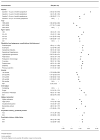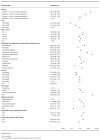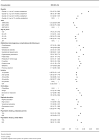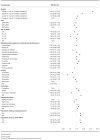Obstetrical, pregnancy and socio-economic predictors for new-onset severe postpartum psychiatric disorders in primiparous women
- PMID: 28112056
- PMCID: PMC5429203
- DOI: 10.1017/S0033291716003020
Obstetrical, pregnancy and socio-economic predictors for new-onset severe postpartum psychiatric disorders in primiparous women
Abstract
Background: Childbirth is a potent trigger for the onset of psychiatric illness in women including postpartum depression (PPD) and postpartum psychosis (PP). Medical complications occurring during pregnancy and/or childbirth have been linked to postpartum psychiatric illness and sociodemographic factors. We evaluated if pregnancy and obstetrical predictors have similar effects on different types of postpartum psychiatric disorders.
Method: A population-based cohort study using Danish registers was conducted in 392 458 primiparous women with a singleton delivery between 1995 and 2012 and no previous psychiatric history. The main outcome was first-onset postpartum psychiatric episodes. Incidence rate ratios (IRRs) were calculated for any psychiatric contact in four quarters for the first year postpartum.
Results: PPD and postpartum acute stress reactions were associated with pregnancy and obstetrical complications. For PPD, hyperemesis gravidarum [IRR 2.69, 95% confidence interval (CI) 1.93-3.73], gestational hypertension (IRR 1.84, 95% CI 1.33-2.55), pre-eclampsia (IRR 1.45, 95% CI 1.14-1.84) and Cesarean section (C-section) (IRR 1.32, 95% CI 1.13-1.53) were associated with increased risk. For postpartum acute stress, hyperemesis gravidarum (IRR 1.93, 95% CI 1.38-2.71), preterm birth (IRR 1.51, 95% CI 1.30-1.75), gestational diabetes (IRR 1.42, 95% CI 1.03-1.97) and C-section (IRR 1.36, 95% CI 1.20-1.55) were associated with increased risk. In contrast, risk of PP was not associated with pregnancy or obstetrical complications.
Conclusions: Pregnancy and obstetrical complications can increase the risk for PPD and acute stress reactions but not PP. Identification of postpartum women requiring secondary care is needed to develop targeted approaches for screening and treatment. Future work should focus on understanding the contributions of psychological stressors and underlying biology on the development of postpartum psychiatric illness.
Keywords: Acute stress disorder; obstetrical predictors; postpartum depression; postpartum psychosis; pregnancy..
Conflict of interest statement
None.
Figures




References
-
- Anderson PK. Statistical Models Based on Counting Processes. Springer-Verlag; New York: 1993.
-
- Ayers S, Rados SN, Balouch S. Narratives of traumatic birth: quality and changes over time. Psychological Trauma. 2015;7:234–242. - PubMed
MeSH terms
Grants and funding
LinkOut - more resources
Full Text Sources
Other Literature Sources
Medical
Miscellaneous

